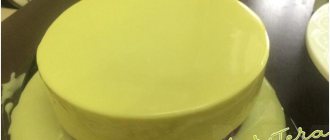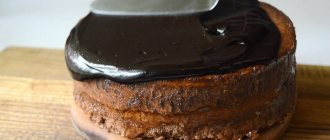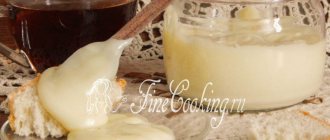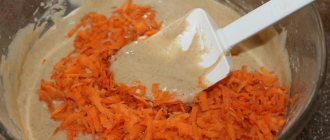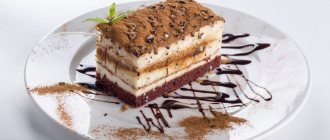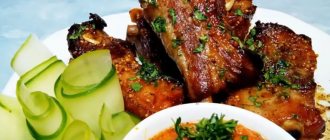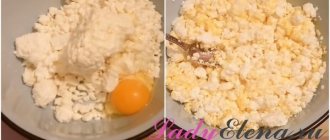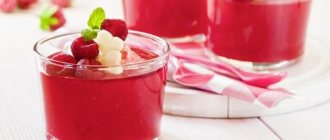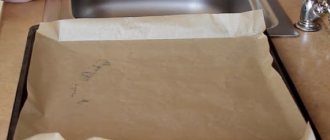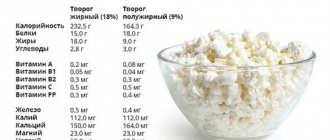The wonderful Christian holiday of Easter is coming soon and we have already begun to prepare for it with all our might. Choose recipes for baking Easter cakes and sweet cottage cheese Easter, look for the most interesting ways to color Easter eggs using paints or other products. There is still a lot of work to do. But today I want to suggest focusing on just one topic. For example, I have already chosen how I will bake Easter cake, but I have not yet decided how to prepare the icing for the cake. As it turns out, there are a lot of such cooking recipes and you can easily get lost in them, because even the glaze can be different, and there are so many accompanying problems that can arise with it. For example, classic sugar icing can crumble and fall off the cake ahead of time, spoiling its festive appearance. What to do if you want colored icing or chocolate. How to choose and what to cook in the end? Let's figure it out together.
How to make sugar icing for Easter cake - the easiest recipe without eggs
The simplest and most popular glaze for Easter cake is white sugar, made from powder. Contrasting with the ruddy Easter cake, it looks very beautiful and complements it perfectly in taste. Personally, since childhood, I liked pieces of cake with icing; if it fell off, I didn’t want to eat such cake anymore. Glaze is an essential element of Easter cake, without it I can hardly imagine this pastry.
- You may be interested in: Chocolate sausage made from cookies with condensed milk. 3 detailed recipes
For the sugar glaze you will need:
- powdered sugar - 100 grams,
- hot milk - a few tablespoons.
Preparation:
This is the most basic recipe for making icing sugar. It uses a minimum of ingredients and is suitable for those who doubt their abilities and have never prepared icing for Easter cake before.
The base of this glaze is powdered sugar. Moreover, I suggest grinding it yourself in a coffee grinder to personally make sure that there are no lumps and the glaze will be smooth and uniform.
Pour powdered sugar into a deep plate. Heat half a cup of milk and add a tablespoon of milk to the powder and stir until there are no lumps.
Stir in stages. We poured a spoonful, stirred it, realized that the powder was not all wet, so we added another spoonful. This way you won’t overfill the milk and won’t have to add powder. It may turn out that there is no more finished powder left. Why risk ruining the icing in vain?
The glaze of the desired consistency will stretch well and fit like a snake into the plate, and then slowly spread. In appearance it looks like high-quality condensed milk, maybe a little thicker.
To apply frosting to a small cake, you can simply dip the top into the bowl of frosting.
Large cakes can be spread with a spatula or spoon. Be sure to let the glaze flow beautifully down the sides of the cake in droplets.
Now you can place dried fruits, candied fruits and nuts on the glaze. You can sprinkle with colorful confectionery sprinkles. Let the glaze harden and the beautiful Easter cake decoration is ready.
With creamy taste and vanilla aroma
Milky white icing with a creamy taste can be obtained if you follow the first recipe, but use milk instead of water. Citric acid is not allowed, as it will instantly curdle the milk and no glaze will work. Instead of acid, use molasses or glucose syrup. You will have to cook the glaze a little longer with them, but it is guaranteed not to crystallize. 50 g of butter added at the end of cooking will make the glaze shiny and vanillin aromatic. You can check the readiness of the glaze like this: drop a little glaze into a glass of cold water. If it falls to the bottom in the form of a thick cake, it means it’s ready. Apply it with a brush in several layers.
Protein glaze for Easter cake
The glaze for the cake from egg whites and powdered sugar is also very quick and easy to prepare. As in the previous recipe, the base of the glaze will be very finely ground powdered sugar. The smaller the better. And we will knead it with egg white, which will make the glaze more durable, but at the same time airy. You love meringue, it is prepared in a similar way.
For the white glaze you will need:
- powdered sugar - 200 grams,
- egg white - 1 piece,
- lemon juice - 1 teaspoon.
Preparation:
1. Wash the raw egg thoroughly with baking soda. Then break and separate the white from the yolk. Place the egg white in a bowl where it will be convenient to whisk the glaze.
2. Grind the sugar into powder, for example using a coffee grinder. Then sift the powder through a sieve so that no large particles or lumps remain. They will not make the glaze so uniform and smooth, and large particles of sugar will not allow it to thicken. Add part of the powder, a third or a quarter, to the bowl with the protein.
3. Beat the powder and egg whites with a mixer until the glaze thickens and becomes opaque white.
4. Add a teaspoon of lemon juice to the glaze. If you don’t have fresh lemon, you can make a solution of citric acid. Continue beating until stiff peaks form.
5. The protein glaze for the Easter cake should be thick and smooth, spreading very slightly when you pour or spread it on the Easter cake.
The protein glaze is ready, you can spread it on the Easter cake and sprinkle with dried fruits and nuts. While the glaze has not hardened, they will stick well and will not crumble.
Marshmallow
You can easily and quickly make marshmallow frosting. Unlike the classic one, the recipe for which is given above, it does not last long. It is applied immediately. The main advantage of this glaze is that even a beginner can make it. It always turns out homogeneous, tender and plastic. It hardens on top, but remains moist and soft inside. For this reason, if you plan to decorate a cake or Easter cake, this must be done very quickly, before the icing loses its stickiness. By the way, this milk glaze is most suitable for Easter cakes.
To prepare it, you need to take a 100-gram bag of marshmallows, a tablespoon of butter, the same amount of lemon juice and from 120 to 150 g of powdered sugar. The secret to the excellent consistency of this icing is the use of powdered sugar. Sand – no way! Instead of marshmallows, you can take marshmallows, but you cannot replace the powder with sugar. Its crunchy crystals will ruin the entire dessert. This glaze also cooks very quickly, so to prevent it from burning, use a water bath.
Place marshmallows in a small saucepan, add butter and citric acid. Place this pan in a larger container of hot water. Put it on fire. Stir. Once the zafir has melted, start adding powder. Stir all the time. Determine density experimentally. If it is too thin, it will run off the biscuit, and if it is too thick, it will be difficult to apply.
Pour hot glaze over the cake, sprinkle colorful dragees on top and leave to harden. After a couple of tens of minutes, the glaze will acquire what is called a presentation.
Glaze for Easter cakes with gelatin - how to make it so it doesn’t crumble
White glossy and elegant sugar glaze can be made not only from pure powder or eggs, but also with gelatin. Thanks to this ingredient, the glaze becomes less fragile and, when finished, does not crumble on the cake at the moment when the cake is cut with a knife. It freezes very beautifully, tastes wonderful and sweet and sticks well on Easter cakes. Just what you need on the holy holiday of Easter.
To prepare you will need:
- sugar - 1 glass,
- gelatin - 1 teaspoon,
- water - 6 tablespoons.
Preparation:
1. In a small bowl, combine a teaspoon of gelatin and two tablespoons of water. Mix thoroughly and leave for a few minutes to allow the gelatin to swell.
2. Place sugar in a small saucepan and add 4 tablespoons of water. Stir and place on low heat. Heat until the sugar dissolves.
3. As soon as the syrup boils, remove it from the heat, let it cool slightly and add the swollen gelatin. Stir until the gelatin lumps are completely dissolved. In warm syrup it should dissolve without a trace.
4. Pour the syrup with gelatin into a convenient container and beat with a mixer until the glaze turns white and becomes thick.
The thick and elastic glaze for Easter cakes can now be spread. The longer it sits and cools, the thicker it will become. The finished glaze will not harden, like glaze on whites, for example, it will remain a little soft and therefore will not break or crumble.
Feel free to decorate the cakes with this glaze, then cut them into even pieces; the gelatin glaze will hold its shape and appearance perfectly. No cracks or broken pieces. Ideal beauty.
Third stage
To turn the resulting clear syrup into a milky white glaze, you need to beat it. This is not a difficult matter. Classic glaze is kneaded to a white cream by stretching it with a porcelain knife over a marble board.
The glaze is poured onto the board. Then the knife is lifted, moved and lowered until it becomes uniformly white. This process is quite long. If you have a mixer and attachments for beating the dough, it can be reduced several times.
To work with the mixer, you need to take two bowls of different sizes - put ice in the larger one, and pour syrup into the small one. It is also advisable to pour large (chestnut-sized) pieces of ice onto it. Whisk the glaze together with ice. It will melt and cool the icing, but the water will not mix with it. Then you just pour it out. Whipping with ice reduces the time it takes for the syrup to turn into glaze to 10-15 minutes, while mixing on a marble board lasts at least 40 minutes.
Determining the readiness of the glaze is very simple. This can be seen by how the syrup changes its consistency and color. When it turns white, stops sticking and forms easily, like heated plasticine, the glaze is ready. Wrap it in a wet cloth and place it in a plastic container. After a day, the glaze will stabilize and can be used - just warm it up a little in a water bath or near a warm radiator. You can apply it either using a spatula, spreading the surface of the biscuit, or placing it in a cornet, for squeezing out in the form of a thin thread and drawing.
Frosting made according to this recipe can be stored in the refrigerator for as long as desired.
Next are three more recipes. They are much simpler than the first, but in taste and appearance they are in no way inferior to it.
Chocolate glaze on gelatin that does not crumble
Chocolate glaze prepared according to this recipe holds its shape just as well as sugar glaze made with gelatin. It is perfect for both cake and Easter cake, as it will not spread too much and will not crumble when cut. Gelatin makes it elastic enough that it remains nice and even under any conditions. It is prepared from cocoa powder and cream, so it tastes simply excellent, like milk chocolate, beloved by many.
You will need:
- cocoa powder - 65 g,
- cream 30% - 100 ml,
- water - 175 ml,
- sugar - 150 g,
- gelatin - 10 gr.
Preparation:
1. First, soak 10 grams of gelatin powder with two tablespoons of water. Mix the gelatin with water in a small cup and let it swell for a while.
2. In a separate small saucepan, combine sugar, water and cream. And put it on fire.
3. Stirring, bring this mixture to a boil. But don’t boil too much, it should just start to boil. The sugar should completely dissolve.
4. As soon as it boils, put cocoa powder in a saucepan. It must be sifted through a sieve to avoid lumps. Lumps will not dissolve well and may remain in the finished glaze.
5. Stir the cocoa powder well in this solution and after the mass becomes homogeneous, remove it from the stove and place the swollen gelatin into the still hot mixture.
6. Thoroughly stir gelatin into hot chocolate. All lumps should disperse. If you cannot mix them completely, you can strain the glaze through a sieve.
7. In order for the glaze to thicken to the desired consistency and be able to be applied to the cake, it must cool to about 35 degrees. THEN it will slowly spread and leave beautiful streaks on the sides of the cake.
The chocolate glaze for the Easter cake is ready. It will look very beautiful if the cake topped with this glaze is sprinkled with coconut flakes.
Happy holidays!
We reveal the secrets of making milk glaze with cocoa
And for lovers of delicate chocolate taste, we have prepared a recipe for icing with the addition of cocoa powder. The unobtrusive chocolate taste of the coating will not only decorate cakes and other desserts, but also add light chocolate notes to their taste.
To prepare the coating, we will need:
- 50 grams of butter and the same amount of cocoa;
- 60 ml milk;
- 60 grams of powdered sugar.
Expert opinion
Anastasia Titova
Confectioner
Ask a Question
Tip: Cocoa powder is a completely natural product. When purchasing a product, pay attention to the RAW or Live labels. Did you manage to find such a product? Congratulations. This means that cocoa retains all the beneficial vitamins.
Cooking process:
- Butter mode in small pieces. Place the product in a saucepan and bring the ingredient to a liquid consistency. After heating, remove the oil from the heat.
- Pour milk into a saucepan, bring to a boil, and remove from heat. Mix the dairy products and beat lightly with a whisk.
- Sift the dry ingredients through a sieve. We introduce them into the liquid. Bring until a homogeneous consistency is formed.
This glaze goes very interestingly with chocolate cakes, poppy seed buns, baba, and muffins.
Pink glaze with beet juice
I would like to recommend this recipe to those who want to make icing for Easter cakes, but leave it the usual white color, and add some variety and color. In this case, food coloring is not used in powder form, but natural, which means it is more healthy and suitable even for small children. Who wouldn’t want to make such a bright and healthy Easter cake for Easter?
You will need:
- powdered sugar - 200 grams,
- egg white - 1 piece,
- beets - 1 pc. small,
- lemon juice - 1 tablespoon.
Preparation:
1. Separate the white from the yolk into a large bowl. Try to break it so that not a single drop of yolk gets in. Whisk it until it foams and turns a little white.
2. Now gradually add powdered sugar. Sift it through a sieve, and rub any lumps you find with a spoon.
3. First add a third of the pood and mix it with the protein until the lumps disappear. Then add the next part and gradually mix it all in.
4. When the protein and powder turn into a thick paste-like mass, add lemon juice. Stir further until all the juice has dissolved into the glaze.
5. Peel the small beets and grate them on a fine grater.
6. Place the grated beets in a bag made of several layers of gauze and squeeze the juice out of them into a small cup.
7. Now add the resulting beet juice to the glaze one teaspoon at a time and mix. Depending on how intense you want the color, add as many spoons. But I don’t recommend that you put too much, as the beetroot flavor may become too pronounced.
8. The finished pink icing for the Easter cake will be thick and glossy. When covering the baked goods, it will harden and remain in a beautiful shape.
You can prepare icing for Easter cake and other colors in exactly the same way. Carrot juice will produce orange, spinach juice will produce green, and red cabbage will produce blue. Try it and you will be able to decorate your Easter cake.
Glaze for decorating baked goods (24 recipes with photos)
Glaze for decorating confectionery products
The main attraction of confectionery products lies in their decoration and filling. Icing is basically a sugar paste with various flavorings and is thin enough to pour and spread in a thin layer. It is used not only for decoration, but also to improve the taste of a wide variety of dessert pastries. The basis of the glaze is sugar or powdered sugar, which can be stabilized by egg whites, citric acid, and invert syrup. The finished mass has a boiling white color and a barely noticeable glossy sheen. Almost all types of glazes that contain sugar or powdered sugar are called “sugar”. Preparing the glaze is quite simple: all ingredients are thoroughly mixed with a whisk or mixer. When using powdered sugar, a thinner and more delicate consistency is obtained, which significantly improves the quality of the product. You can glaze confectionery products in two ways: simplified or real glaze . If the frosting is made without egg whites, it is a simplified frosting, but the frosting with whipped egg whites is a real frosting. Products with real glaze look more beautiful and taste better. Apply the glaze to the surface of the cooled flour confectionery products with a special silicone brush, and then (depending on the recipe and the products being decorated) dry it in a cool oven (80-100°C) or leave it as is. For example, semi-finished protein products are usually dried. To highlight the taste of the semi-finished product and give it color, natural dyes are added to the glaze. From the juice of vegetables, berries and fruits you can get a wonderful palette of food colors. The pleasant aroma of the glaze is added by infusing dessert alcohol (cognac, liqueur, liqueur), adding cinnamon, vanilla, citrus zest, chocolate, etc. Instead of natural raw materials, artificial colors and flavors can be introduced.
Useful tips
● To prepare lean glaze, it is advisable to use filtered drinking water, which should be placed in the freezer in advance. ● To make the glaze uniform, smooth and without lumps, all dry powder ingredients must be sifted through a strainer. ● The glaze must cool slightly before use, since the hot mixture may drip off the baked goods or spread unevenly. ● In order for the glaze to cover the confectionery product evenly, you need to apply it in layers using a special spatula: first, over the entire surface of the cake or pastry in a thin layer, and then go over it several more times. ● If the glaze is prepared using a cold method, it is recommended to apply it to the surface of the confectionery product immediately, since over time it will harden greatly and will not be able to be evenly distributed over the surface of the baked goods. ● The top of the glaze can be decorated with chopped nuts, coconut shavings, pieces of multi-colored marmalade, candied fruits, jelly, dried fruits - it all depends solely on the baking recipe and your taste preferences. ● If you need to add buttercream decorations to the icing, you need to wait until it hardens completely. ● If the glaze is applied to a surface greased with cream, it is advisable to sprinkle cocoa powder or powdered sugar on top. ● To calculate the weight of a particular product, the Comparative Table of Weights and Measures will help you
It is important!
Citric acid is found in lemons and some other fruits and berries, but is obtained mainly by fermenting sugars. Citric acid is sold in crystals. One spoon of crystalline citric acid is dissolved in two spoons of hot water and the resulting solution is used in the manufacture of preparations, dosing it in drops or teaspoons (50-55 drops in 1 teaspoon of acid solution). The juice squeezed from 1 lemon corresponds to approximately 5 g of crystalline acid, or 2 teaspoons of its solution.
Let cooking become your favorite pastime and a wonderful hobby!
ஓજஓજஓ
Recipe 1. The simplest iced glaze
The simplest glaze is a paste of powdered sugar, warm water or fruit juice, which forms a translucent, not entirely solid glaze. A harder matte glaze is made by mixing sugar (in the form of sand or powder) and egg whites. This icing, called royal icing, spreads easily and hardens quickly. Ingredients: ✵ powdered sugar - 160-180 g (1 glass); ✵ water ‒ 60-70 ml (2-3 tablespoons). Preparation Sift the powdered sugar over a bowl to remove any lumps. Gradually add warm water, spoonful at a time, into the small well made in the powdered sugar, stirring and rubbing after each addition to create a light, liquid consistency. Then beat the mixture until it becomes white and smooth.
When preparing the glaze, you should take into account that if it turns out to be a little liquid, then add powdered sugar, but if it is too thick, then add water. The finished glaze should coat a spoon in a thin layer. If desired, you can add a few drops of natural food coloring. Prepared iced glaze hardens quickly, so it must be used immediately.
Cook with pleasure!
ஓજஓજஓ
Recipe 2. Powdered sugar custard glaze
Ingredients: ✵ powdered sugar - 100 g (5 tablespoons); ✵ water ‒ 25-50 ml (1-2 tablespoons). Preparation: Sift powdered sugar into a pot or saucepan, add water and put on fire. Stirring constantly, bring to a boil and let stand for 2-3 minutes until the mixture becomes transparent. It is very convenient to check the readiness of the glaze with a twisted wire. When you dip it, a stable film forms.
Now you can coat the baked goods: coat or dip directly into the glaze. The glaze hardens very quickly, so it needs to be used quickly or then simply melted again over the fire. If desired, you can always increase the amount of ingredients, as well as add natural food coloring to make the baked goods look original and festive.
Cook with pleasure!
ஓજஓજஓ
Recipe 3. Simplified powdered sugar glaze
Ingredients: ✵ powdered sugar - 160-180 g (1 glass); ✵ water ‒ 75 g (3 tablespoons); ✵ aromatics - optional; ✵ food coloring - optional. Preparation Sift the powdered sugar through a strainer into a small saucepan, add warm water, aromatics and, stirring with a spatula, heat to 40°C. If the glaze turns out too thick, you need to add a little water, and if it’s too thin, add powdered sugar. If desired, the glaze can be painted any color. To speed up drying and improve the quality of the glaze, you can add 3 egg whites instead of water (i.e., replace every 1 tablespoon of water with 1 white).
Cook with pleasure!
ஓજஓજஓ
Recipe 4. Simple sugar glaze
A simple recipe for such sugar glaze becomes a real lifesaver during Lent. Ingredients: ✵ granulated sugar - 180-200 g (1 glass); ✵ water ‒ 100-125 g (0.5 cups). ✵ flavorings (vanilla, almond, rum) - optional. Preparation Pour water into a saucepan, dissolve sugar in it, bring to a boil and boil, removing foam, until large transparent bubbles appear (they appear at a syrup temperature of about +110°C). Cool the glaze until hot (your finger can tolerate it, but it’s very hot). Add flavorings and you can start glazing. Apply glaze to large gingerbread cookies and gingerbread cookies with a special brush. Small gingerbread cookies can simply be immersed in the glaze, mixed, then carefully removed with a slotted spoon and placed on a wire rack so that the excess syrup drips off and the rest hardens, turning into gingerbread glaze.
Cook with pleasure!
ஓજஓજஓ
Recipe 5. White lean glaze
We offer a recipe for icing for decorating various cookies and gingerbreads. Lemon juice or water acidified with citric acid is used as a diluent. At the same time, the taste of white glaze is simply incredible. It gives a slight sourness and the aroma of fresh lemon, and very successfully complements even the simplest baked goods. Ingredients: ✵ powdered sugar - 180-200 g (1 heaped glass); ✵ water ‒ 50 ml; ✵ lemon juice - 50 ml (or citric acid on the tip of a knife + 50 ml of water); ✵ flavoring - 1 pinch (optional). Preparation Pour the powdered sugar into a deep bowl. Pour in water and stir vigorously with a whisk or beat with a mixer. Then gradually add lemon juice and beat again until a thick viscous mass with a slight glossy sheen is formed. Apply the glaze to the pastry with a silicone brush and leave until dry. If desired, you can replace lemon juice with any other citrus fruit or add chopped berries, which you probably have in your freezer. However, in this case the glaze will already take on the color of the added additive.
Cook with pleasure!
ஓજஓજஓ
Recipe 6. Classic sugar glaze
Ingredients: ✵ powdered sugar - 200 g (10 tablespoons); ✵ water - 150 ml (6 tablespoons); ✵ lemon juice - 4-5 drops. Preparation Pour hot water into the powdered sugar and mix thoroughly with a wooden spoon to form a homogeneous shiny mass. Cook until thickened in a water bath. At the very end add lemon juice.
Cook with pleasure!
ஓજஓજஓ
Recipe 7. Protein glaze with invert syrup
This glaze turns out lighter and airier. It is used to decorate gingerbread cookies and Tula gingerbreads, and to cover marzipan and other confectionery products. Ingredients: ✵ egg whites - 4 pcs.; ✵ salt - 1 pinch; ✵ vanilla flavoring - optional; ✵ dye - optional. For invert syrup: ✵ water - 150 ml (6 tablespoons); ✵ powdered sugar - 200 g (10 tablespoons); ✵ lemon juice - 20 ml (or 1 pinch of citric acid + 20 ml of water). Preparation: Boil thick invert syrup from water, powdered sugar and lemon juice. Cool the finished syrup to +60-70°C. Add a pinch of fine salt to the chilled egg whites and beat into a thick, stable foam. Then you need to gradually pour invert syrup into the fluffy protein mass in a thin stream, ensuring a continuous mixing process. If desired, you can add a little vanilla flavoring and a couple of drops of natural food coloring. Use the finished glaze when warm to decorate confectionery products. After application, dry lightly in the oven.
Cook with pleasure!
ஓજஓજஓ
Recipe 8. Sugar-protein glaze
Cookies and gingerbreads with sugar-protein glaze look more beautiful, retain their freshness better and taste more pleasant. Ingredients: ✵ granulated sugar - 180-200 g (1 glass); ✵ egg whites - 2 pcs.; ✵ water ‒ 200 ml (1 glass); ✵ aromatic substances; ✵ food paints. Preparation Boil sugar and water until tested into a soft ball. Beat the egg whites well into a fluffy foam. Gradually pour the hot thick syrup in a thin stream into the whipped egg whites, continuing to beat the mixture. Then add aromatic substances, natural food colors and, stirring with a wooden spatula, heat to 60-65°C. After this, the product (baked goods) can be glazed with a special brush and then dried. Tip ☞ The glaze will be even better and tastier if in this recipe instead of sugar syrup you use honey boiled to the desired thickness.
Cook with pleasure!
ஓજஓજஓ
Recipe 9. Perfect protein glaze
The egg white sugar glaze made using this recipe is simply perfect! It is dense, white, there is no transparency, it does not spread on the surface of the cake, but lies like a “cap”. The whole secret is in the dry egg white with increased whipping ability - albumin. Ordinary chicken eggs have a number of features that interfere with the preparation of high-quality glaze. Firstly, the eggs must be very fresh, otherwise stable peaks will not be visible. Secondly, it is unacceptable for a single drop of yolk to get into the separated whites - this significantly reduces their whipping ability. Thirdly, albumin is a product in which the parameters of whipping and foam stability are higher than in fresh egg white. Ingredients: ✵ powdered sugar - 110 g; ✵ albumin (dry egg white) - 8 g; ✵ water ‒ 65 ml. Preparation To restore dry egg white, you need to pour a little water (5 ml) into it and mix thoroughly. Then, continuing to stir, add the rest of the water (60 ml). After 10-20 minutes the powder will swell, and then you can beat it. Beat the reconstituted egg white slowly at first, and when the mixture begins to bubble, gradually begin to increase the speed. Continue beating until the whites form a stiff mixture (when you remove the whisk, protein peaks follow, but do not immediately fall off). Finally, add the powdered sugar in portions (2 tablespoons at a time), beating after each addition.
Cook with pleasure!
ஓજஓજஓ
Recipe 10. Royal icing
Royal icing is a thick paste of powdered sugar and egg whites with lemon juice. This glaze is ideal for Easter cakes because... spreads easily and hardens quickly. Royal icing is made from the freshest egg whites. To prepare it, eggs are taken that have been stored for no more than 7 days. Quality can be determined by the yolk: the more liquid it is, the less fresh the eggs are considered. Ingredients: ✵ powdered sugar - 1 glass (160-180 g); ✵ egg white - 1 pc.; ✵ lemon juice ‒ 1 tbsp. spoon. Preparation Carefully separate the egg whites from the yolks. You need to keep in mind that if particles of yolk get into the white, the glaze may not work out at all. Sift the powdered sugar through a strainer so that there are no lumps. By the way, you can make it yourself from sugar using a coffee grinder. Squeeze lemon juice. Gradually stir half the caster sugar into the cooled egg whites, then add the lemon juice. Using a mixer, whisk or fork, beat the mixture vigorously until it is smooth and fluffy. Adding the remaining powdered sugar in parts, continue beating until you get a dense, shiny protein mass that does not flow off the whisk at all and holds its shape well. It will take 15 minutes by hand, and 7 minutes with a mixer.
The finished glaze should be used immediately for its intended purpose or covered with a damp cloth to protect it from drying out. Protein glaze can be stored in the refrigerator under film for several days.
Cook with pleasure!
ஓજஓજஓ
Recipe 11. Protein glaze for Easter cakes
Snow-white icing for Easter cakes or Easter cupcakes is very simple and incredibly quick to prepare. If you add a little fruit or berry juice to this glaze, you will get colorful Easter cakes that children will really like. But still, white is the most solemn color. The protein glaze hardens for a short time and looks very festive and appetizing. In addition, any decorative multi-colored sprinkles or candied fruits fit perfectly on it. Ingredients: ✵ powdered sugar - 200 g; ✵ egg white - 2 pcs.; ✵ salt - 1 pinch. Preparation Beat cooled, salted egg whites with a mixer or whisk for 3 minutes until fluffy. Then, without ceasing to beat, gradually add powdered sugar. Well-whipped frosting has a smooth, dense structure. It will not crack when applied to baked goods. In order for the protein glaze to cover the product more evenly and to be glossy, a thin layer of thick jam or marmalade is applied to the surface of the cake. To make the glaze stick better, you can dry it in the oven by placing the cake there for 3-5 minutes. When slicing the cake, the dried glaze may begin to crack a little, crumble and crumble. This, of course, does not spoil it or affect the pleasant sugar taste, but to prevent this, you need to store glazed products in a tightly closed container.
Cook with pleasure!
ஓજஓજஓ
Recipe 12. Protein glaze in a water bath
Any pastry will become even more elegant if you cover it with snow-white glaze. An excellent glaze for decorating Easter cakes, cookies, gingerbread, cupcakes, rum baba and other confectionery products is made at the rate of: 1 egg white per 45-50 g (1/4 cup) sugar. Ingredients: ✵ granulated sugar ‒ 1 glass (180-200 g); ✵ egg whites - 4 pcs. Preparation Place a pan of water on the fire, bring to a boil and organize a water bath. Place the egg whites in a deep bowl, add sugar and beat in a water bath for 5 minutes. Then remove from heat and beat for another 5-7 minutes to obtain a glossy and snow-white meringue. Immediately spread the glaze onto the cooled baked goods. It turns out a little sticky, but beautiful (the colored sprinkles stick well), after a while the glaze will harden.
Cook with pleasure!
ஓજஓજஓ
Recipe 13. White and colored raw glaze
Raw glaze is the name given to a protein mass of varying degrees of thickness obtained by mixing egg whites with powdered sugar. Depending on its thickness, it has different purposes. Thick glaze is used to apply contours and patterns to confectionery products in the form of cookies or gingerbread. A less thick mass is applied (glazed) on the surface of cakes and other large holiday baked goods. The thinnest consistency (like thick sour cream) is usually used for pouring into a contour outlined with thick glaze. Most often, New Year and Christmas cookies are decorated this way. The latter type of raw icing is also good for decorating Easter cakes or Easter cupcakes. Ingredients: ✵ powdered sugar ‒ ½ cup (80-90 g); ✵ egg white - 1 pc.; ✵ lemon juice (freshly squeezed) - 1 teaspoon. Preparation Like any other thing, preparing glaze from egg white and powdered sugar has its own characteristics. Therefore, here you need to adhere to time-tested recommendations. Combine egg white and lemon juice in a clean bowl and beat with a fork, whisk or mixer until smooth. Only then can you add sifted powdered sugar in small portions. Mix well until you get the consistency you want. The final hardness/softness of the glaze is adjusted by the amount of powdered sugar. By increasing its quantity, you can easily and simply prepare a thicker type of glaze. Keep in mind that if you add powdered sugar in large quantities at once, you will get a dull, grayish and heavy mass. But in order to get a snow-white, light and slightly glossy glaze, you need to be patient and take your time during the preparation process. Photo 1 shows what consistency the raw glaze used for squeezing when drawing patterns should be. As you can see, in this case you need to achieve the so-called “stable peaks”. To create drawings and inscriptions, use a culinary syringe or a plastic bag with a cut corner.
Photo 2 shows what consistency the glaze should be for glazing surfaces. As you can see, in this case it rests on a whisk or spoon, but at the same time hangs softly, as if flowing from them. Photo 3 shows what the glaze should be like for pouring: it is quite thick, but flows easily from a spoon. By adding natural food coloring to white raw glaze, you can get colored glaze. Using this recipe, you can prepare such a delicate snow-white or multi-colored decoration for holiday baking quite simply, the main thing is to be patient, and over time the necessary skills will appear.
Cook with pleasure!
ஓજஓજஓ
Recipe 14. Simple milk glaze
Homemade baking is indispensable without glaze. Most often, dark chocolate glaze is used to prepare desserts, but sometimes white confectionery glaze is also needed. Ingredients: ✵ powdered sugar - 240-270 g (1.5 cups); ✵ milk - 50 ml (2.5 tablespoons). Preparation Pour the milk into a deep bowl with powdered sugar and beat with a mixer or blender at medium speed until thick. That's it, so simple and fast. White icing for Easter cakes, cakes, buns, cookies is ready. Now you can decorate delicious homemade cakes.
Cook with pleasure!
ஓજஓજஓ
Recipe 15. Milk-vanilla glaze
Ingredients: ✵ butter - 25 g (1 tbsp); ✵ milk - 40 ml (2 tablespoons); ✵ powdered sugar - 1 cup (160-180 g); ✵ vanilla sugar - 1 package (8 g); ✵ salt - 1 pinch. Preparation Melt the butter in a saucepan, add milk and salt to it, gradually dissolve the powdered sugar. Mix everything until the consistency of thick sour cream or cream. Add vanilla sugar to the finished glaze. If the mixture turns out to be too thick, you can add a little milk to it; if it’s liquid, you can add powdered sugar.
Cook with pleasure!
ஓજஓજஓ
Recipe 16. Creamy vanilla glaze
Option 1
Ingredients: ✵ powdered sugar - 2 cups (320-360 g); ✵ heavy cream - 0.5 cups (100-125 g); ✵ butter ‒ 1 tbsp. spoon (25 g); ✵ vanillin - on the tip of the knife. Preparation Pour the cream into a saucepan, add the butter and heat over medium heat until the butter melts. Then gradually add powdered sugar and vanilla into the hot cream mixture and beat everything with a mixer until the glaze has completely cooled and a thick and homogeneous consistency is obtained.
Option 2
Ingredients: ✵ granulated sugar - 300 g (12 tablespoons); ✵ cream (fat content not less than 20%) - 250 ml (12.5 tablespoons); ✵ butter - 50 g (2 tablespoons); ✵ vanilla sugar - 8 g (1 teaspoon). Preparation Place the cream and granulated sugar in a saucepan and, stirring, cook over low heat for 10-20 minutes until the mixture thickens. Then add butter and vanilla sugar, stir until smooth and remove from heat. Wait a few minutes and pour over the homemade cakes. How to check the readiness of the glaze? Place a container of cold water next to the stove where the glaze is being cooked. While stirring the boiling glaze, pour a couple of drops into cold water with a spoon, and if they dissolve, then you need to keep it on the fire. When the drops remain in the shape of a ball, the buttercream icing will be considered ready. If you put this glaze in silicone molds and cool, you will get a soft, delicious creamy vanilla sherbet.
Cook with pleasure!
ஓજஓજஓ
Recipe 17. Creamy caramel glaze
Ingredients: ✵ brown sugar - 0.5 cups (90-100 g); ✵ powdered sugar - 1 cup (160-180 g); ✵ butter - 2 tbsp. spoons (50 g); ✵ milk ‒ 3 tbsp. spoons (60 ml); ✵ vanilla sugar - 1 sachet (8 g). Preparation Melt the butter in a saucepan over low heat, then add the milk and dissolve the brown sugar. Stirring continuously, bring to a boil and cook for 1 minute. Remove the cream-sugar mixture from heat and, stirring, gradually add half a glass of powdered sugar. Beat well, cool, add the rest of the powdered sugar and vanilla sugar and beat again until a thick glaze is obtained.
Cook with pleasure!
ஓજஓજஓ
There are a huge number of recipes for making glaze in various ways. Today, chocolate icing remains one of the popular decorations for baked goods in famous confectionery houses. Create your masterpiece and decorate your baked goods with delicious and delicious glaze.
ஓજஓજஓ
Recipe 18. Simple chocolate glaze
This glaze can be made at home without much effort. In order for it to acquire a chocolate taste, you need to add cocoa powder. For many years, many housewives have been using the simplest recipe for making chocolate glaze, and it does not lose its popularity. Ingredients: ✵ granulated sugar ‒ ½ cup (90-100 g); ✵ water ‒ 3 tbsp. spoons (75 ml); ✵ cocoa powder - 2 tbsp. spoons (50 g). Preparation Pour sugar into a saucepan, add cocoa and drinking water, mix thoroughly, put on moderate heat and, stirring constantly, bring to a boil. Once the sugar has completely dissolved and a bubbly head appears, remove from heat and let cool. During this time, the prepared mixture should thicken well. Once completely cooled, the simple chocolate glaze is ready to use. It can not only decorate cakes and Easter cakes, but also be used as a filling for custard pies.
Cook with pleasure!
ஓજஓજஓ
Recipe 19. Chocolate glaze with sour cream
It is the recipe for making glaze from cocoa powder with the addition of sour cream that is incredibly popular among confectioners and housewives. According to the preparation method, this glaze is considered very simple, and it tastes like real chocolate. This glaze is the highlight of baking and is great not only for cakes, but also for Easter cakes. Ingredients: ✵ granulated sugar - 125 g (5 tablespoons); ✵ sour cream (any fat content) - 75 g (3 tablespoons); ✵ cocoa powder - 75-100 g (3-4 tablespoons); ✵ butter - 25 g (1 tbsp. spoon). Preparation: Place sour cream in a saucepan, gradually add cocoa and sugar, mix gently and heat over low heat. The chocolate mixture must be constantly stirred so that it does not burn or boil. When the sugar is completely dissolved, add butter and mix thoroughly until smooth. This glaze cools very quickly and at the same time becomes very thick, so you should immediately use slightly warm glaze to decorate confectionery or baked goods.
Cook with pleasure!
ஓજஓજஓ
Recipe 20. Chocolate glaze with sour cream and milk
There are many recipes for chocolate glaze and it is prepared more often than other types of glaze. After all, if you don’t know how to quickly decorate a cake or Easter cake, then a beautiful, tasty and aromatic cocoa icing would be the ideal option. Ingredients: ✵ cocoa powder ‒ 2 tbsp. spoons; ✵ sour cream ‒ 2 tbsp. spoons; ✵ milk ‒ 4 tbsp. spoons; ✵ butter - 50 g (2 tablespoons); ✵ granulated sugar - 200 g (8 tablespoons). Preparation Combine butter and sugar in a saucepan and heat, stirring constantly, until the sugar is completely dissolved. Then add cocoa, milk and sour cream, mix everything thoroughly and then keep the mixture on the fire for no more than 3 minutes. The main signs of readiness are sufficient thickness and a uniform, smooth structure. This chocolate glaze is good because it is evenly and beautifully applied to baked goods and does not crumble when cutting.
Cook with pleasure!
ஓજஓજஓ
Recipe 21. Chocolate cream glaze
Frosting is a great addition to homemade baked goods. One of the most popular and delicious versions of this delicacy is cocoa powder icing. You can decorate cakes, pastries, Easter cakes, cookies, and muffins with delicious creamy cocoa glaze without it. Baking immediately becomes even more appetizing and interesting. Ingredients: ✵ granulated sugar - 100 g (4 tbsp. spoons) or powdered sugar - 100 g (5 tbsp. spoons); ✵ cocoa powder - 25 g (1 tbsp); ✵ butter - 50 g (2 tablespoons); ✵ water - 125 ml (5 tablespoons). Preparation: Combine sugar or powdered sugar with water and boil the syrup. Thoroughly grind the softened butter with cocoa powder. Then gradually pour the pre-prepared and cooled sugar syrup into this mixture in a thin stream. That's it, the chocolate buttercream frosting is ready. You need to cover homemade baked goods with it immediately, before the glaze has time to harden. In the recipe, you can replace the cocoa powder with melted chocolate (white or dark). Without adding cocoa or chocolate, you get a white glaze, which is also quite tasty and is often used to decorate baked goods.
Cook with pleasure!
ஓજஓજஓ
Recipe 22. Lenten chocolate glaze with starch
If you urgently need to prepare a delicious dessert or pastry, but you don’t have time to brew the glaze, then you can make chocolate glaze using a cold method using starch. Thanks to its properties, the glaze thickens without cooking and can be used for both hot and chilled baking. To prepare this glaze you do not need dairy products. Lenten glaze turns out even, smooth and fits perfectly on the surface of desserts or baked goods. Ingredients: ✵ cocoa powder (good quality) – 75 g (3 tablespoons); ✵ powdered sugar – 60 g (3 tablespoons); ✵ starch (potato) – 30 g (1 tbsp); ✵ water (ice) – 75-100 ml (3-4 tablespoons). Preparation: Sift cocoa powder into a separate deep bowl using a strainer. It is advisable to buy it of good quality from a trusted manufacturer. Then sift the powdered sugar and starch.
Mix all dry ingredients thoroughly. Gradually add ice water and thoroughly grind the resulting mixture with a spoon or beat with a whisk (fork). The glaze will be ready for use when it thickens and becomes smooth and uniform in consistency.
After covering the products with glaze and drying, it will not crack, but will remain quite soft and very pleasant to the taste. If you need more glaze, you can proportionally increase the mass of added components. Source
Cook with pleasure!
ஓજஓજஓ
Recipe 23. Dark chocolate glaze
A dark chocolate-based glaze that is usually used to decorate sponge cakes and cakes. Ingredients: ✵ powdered sugar - 160-180 g (1 glass); ✵ dark chocolate - 100 g; ✵ butter - 30 g (1 heaped tablespoon); ✵ water - 100 ml (4 tablespoons). ✵ lemon juice ‒ 1 tbsp. spoon (or ¼ teaspoon of citric acid + 1 tablespoon of water). Preparation Melt the dark chocolate pieces and butter in a water bath. Stir the mixture continuously and once completely dissolved, remove from the stove. Cook invert syrup from 100 ml of water, a glass of powdered sugar and lemon juice. Reduce by a quarter and remove from heat.
Place the bowl of chocolate in a water bath again, heat it up and pour in invert syrup in a thin stream. The chocolate mass must be continuously whipped (preferably with a mixer with one whisk). The glaze mixture should boil down a little more, and as soon as the mixture thickens and begins to acquire a noticeable glossy shine, the glaze is ready. Cool it to 60°C and can be used for its intended purpose.
Cook with pleasure!
ஓજஓજஓ
Recipe 24. Chocolate creamy milk glaze
The chocolate glaze for this recipe is practically classic. It perfectly complements any baked goods. A cake, cookies or Easter cake will be even more beautiful and tasty, and most importantly, original, if you top it with aromatic chocolate glaze. You can decorate any desserts, ice cream with it and, if desired, enjoy it just like that. Ingredients: ✵ powdered sugar - 2 cups (320-360 g); ✵ cocoa powder - 2 tbsp. spoons (50 g); ✵ fresh milk - 4 tbsp. spoons (80 g); ✵ butter - 2 tbsp. spoons (50 g); ✵ vanilla sugar - 1 teaspoon (8 g). Preparation: Place butter in a saucepan and heat slightly. Gradually add sifted powdered sugar and vanilla sugar to the softened butter and grind thoroughly. Then add milk and cocoa little by little, stirring until smooth. Cocoa is always added last. After this, keep the mixture over low heat, stirring constantly, for no more than 3 minutes (do not boil). The main signs of readiness are sufficient thickness and a uniform, smooth structure. The finished glaze can be used to coat baked goods. There is no need to worry about the consistency of the glaze: as soon as it cools, it will become even thicker. Delicious and aromatic chocolate glaze will make baking interesting and appetizing.
Cook with pleasure!
ஓજஓજஓ
All rights reserved. Copying material for publication on other sites is prohibited! It is allowed to use an announcement with a picture if there is an active link to the source ladies.by
ஓજஓજஓ
You may also be interested in other sections: Appetizer recipes Salad recipes First course recipes Second course recipes Dessert recipes Drink recipes Sauce recipes Preparing fish for the winter Preparing vegetables and mushrooms for the winter Preparing fruits and berries for the winter All about healthy eating
If you found the page interesting and useful or have something to share, please leave your comment. We will be very grateful to you. ☸ڿڰۣ–
Caramel glaze for Easter cake at home
And for dessert, if I may say so in this article, real caramel glaze. I bet that not many people prepare such glaze for Easter cakes, and in my opinion it’s completely in vain. It has a simply delicious candy taste that you just can’t stop eating. It is especially good if you are preparing not too sweet cakes, then it will create the necessary balance of flavors.
To prepare this glaze, sugar, condensed milk, chocolate and gelatin are used, which makes it soft and tender. This glaze does not crumble or fall off the cake, holds its shape perfectly and does not dry out. True, it's quite a bit sticky. But this, as you know, is to make the expression “finger lickin’ good” literal.
- You may be interested in: Cheesecakes in a frying pan - classic recipes for fluffy cheesecakes
With this, I think I’ll end our short excursion into the variety of glaze recipes before your head starts spinning.
See you again and don’t forget to share recipes!
Recipe 1 (classic)
To prepare the glaze you will need 250 g of granulated sugar and 30 g of lemon juice. Water is taken in a ratio of one to three to sugar. This is the minimum amount of water in which the sugar will completely dissolve. In our case, this is approximately 80-90 g. The ratio of ingredients is quite arbitrary - the readiness of the lipstick is determined during the process of boiling the syrup and evaporating excess water. If there is too much of it, then it is better than too little - you just need to keep the syrup on the fire a little longer.
